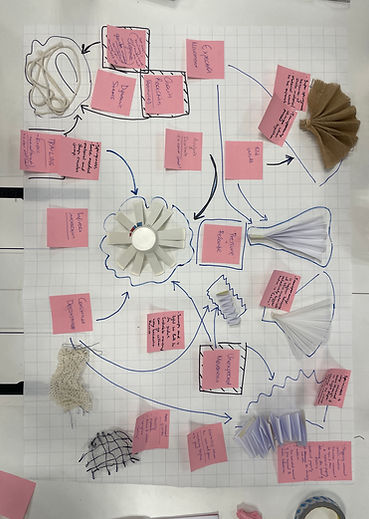'Kinesis'
: movement / activity
Designer(s):
Leda Demetriadou, Saniya Chand, Claire Vos, Zorhab Sarabian
Professor(s):
Miguel Bruns, Amy Winters
Year:
2024
This project explores how speculative materials are used with the “textility of making” [1] approach to develop the Kinesis prototype. Kinesis is an interactive artefact with motion and form inspired by nature and emphasizing in dynamic user interaction and aesthetic experience which evolves around two main transition moments: “Static to Dynamic” and “Expected to Unexpected” to create surprise, curiosity or satisfaction moments to the user. The sculpture consists of four key components: a spinner, grips, body, and base, which together create fluid, dynamic forms which transitions from rigid to flexible. The project balances functionality and expressivity [2] by examining the interaction between user input and artefact adaptability, through haptic input. By applying the theories of affordances, tension-release [3] and “performative interaction” [4], this Kinesis illustrates how design can go beyond functionality to create a sensory-driven, interactive experience.
Pictorial
Contribution to Development
Through the Kinesis project, I explored how form, function, interaction, and materiality could express transitional states and emotional responses. Working with soft materials and using the "textile of making" [1] approach triggered my creativity. This experience enhanced my sensitivity to physical expression and performative interaction, helping me better understand how to communicate transition moments and emotion through motion and tactility. It pushed me to work more experimentally, without fixed outcomes, and to trust in the process of making to discover meaning. This deconstructive approach fuelled the way I worked in my FMP, where I broke down the design into form, functions, and interactions, and approached it by balancing functionality and expressivity. It was important for shaping my design identity, especially in how I approach aesthetics and material exploration from the beginning of the design process.




References
[1] T. Ingold, “The textility of making,” Cambridge Journal of Economics, vol. 34, no. 1, pp. 91–102, 2010. Let me know if you need it included in a compiled reference list or formatted differently.
[2] M. Bruns, S. Ossevoort, and M. G. Petersen, “Expressivity in interaction: A framework for design,” in Proc. 2021 CHI Conf. on Human Factors in Computing Systems, May 2021, pp. 1–13.
[3] A. Winters, S. de Waart, and M. Bruns, “Tension-and-release: A design principle for dynamic materials,” International Journal of Design, vol. 16, no. 2, pp. 1–14, 2022. [Online]. Available: https://doi.org/10.57698/v16i2.01
[4] J. G. Sheridan and N. Bryan-Kinns, “Designing for performative tangible interaction,” International Journal of Arts and Technology, vol. 1, no. 3–4, pp. 288–308, 2008.